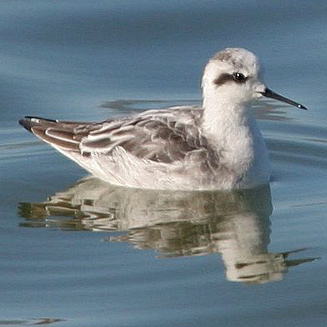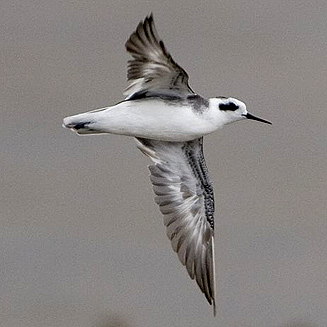|
Phalaropus lobatus (Red-necked
phalarope)
Rooihalsfraiingpoot [Afrikaans]; Grauwe franjepoot
[Dutch]; Phalarope à bec étroit [French]; Odinshühnchen [German];
Falaropo-de-bico-fino [Portuguese]
Life
> Eukaryotes >
Opisthokonta
> Metazoa (animals) >
Bilateria >
Deuterostomia > Chordata >
Craniata > Vertebrata (vertebrates) > Gnathostomata (jawed
vertebrates) > Teleostomi (teleost fish) > Osteichthyes (bony fish) > Class:
Sarcopterygii (lobe-finned
fish) > Stegocephalia (terrestrial
vertebrates) > Tetrapoda
(four-legged vertebrates) > Reptiliomorpha > Amniota >
Reptilia (reptiles) >
Romeriida > Diapsida > Archosauromorpha > Archosauria >
Dinosauria
(dinosaurs) > Saurischia > Theropoda (bipedal predatory dinosaurs) >
Coelurosauria > Maniraptora > Aves
(birds) >
Order: Charadriiformes > Family: Scolopacidae
 |
 |
|
Red-necked phalarope in non-breeding plumage,
Veldrif, South Africa. [photo Trevor Hardaker ©] |
Red-necked phalarope in non-breeding plumage,
Veldrif, South Africa. [photo Trevor Hardaker ©] |
Distribution and habitat
Breeds in the circumpolar region from 65-30° North, heading
south in the non-breeding season to the coast and adjacent ocean of Peru, the
Arabian Peninsula and the South China Sea, while it is a vagrant to the Old
World in including southern Africa. Here it is a rare visitor to the coast of
the Western Cape and central Namibia while a rare vagrant to KwaZulu-Natal, with
two inland records in the Caprivi Strip and Gauteng. It generally stays at sea
in the non-breeding season, although in southern Africa it generally prefers
coastal salt pans and sewage works.
Movements and migrations
It is present in southern Africa from
September-April, mainly November-March.
Food
It mainly eats copepods, crustaceans and insects, doing
most of its foraging in shallow water along with other birds such as
Pied avocets,
Curlew sandpipers,
Ruffs,
Common greenshanks, Hartlaub's
gulls and Cape teals. It catches
prey with downward jabs of its bill, often spinning around on the spot to create
a vortex which draws prey towards it.
Threats
Not threatened.
References
-
Hockey PAR, Dean WRJ and Ryan PG 2005. Roberts
- Birds of southern Africa, VIIth ed. The Trustees of the John Voelcker
Bird Book Fund, Cape Town.
|
